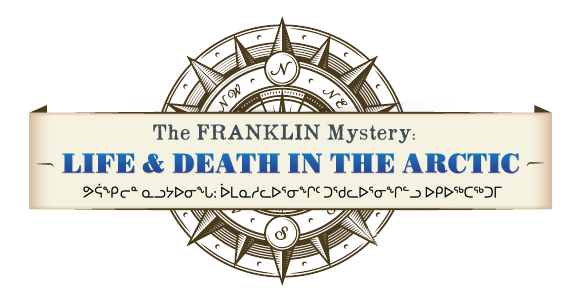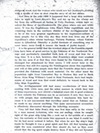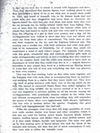Arviligjuarmiut Testimony on Franklin and Others [Reported by Knud Rasmussen] (1931)
It is the general belief that the wrecked ships of the Franklin expedition have been of great service to the Eskimos of the Northwest Passage and particularly remedied their lack of wood and iron for a long time. It is a fact, however, that Franklin's ships were crushed by the ice, even if at first they were found by the Eskimos, still undamaged but abandoned by their crews. I will revert later to the traditions that still live among the Netsilingmiut about this expedition, and will at this point simply state that the Franklin ships have never provided the Eskimos with much material. On the other hand the population right from Committee Bay to Hudson Bay and to Back River, from King William's Land to Kent Peninsula, have had implements of wood and iron that could definitely be traced back to the John Ross Expedition.
The Arviligjuarmiut still had many recollections of their first meeting with white men, and the sober manner in which they told of these experiences, now almost a hundred years old, is good evidence of how reliable the Eskimos can be as narrators if only they have to do with people who understand them. I emphasize this here because it is not uncommon that travellers assert that an Eskimo can be made to say almost anything. This quite unwarranted accusation is effectively discounted through the following accounts:
They tell that John Ross's ship was first seen early in the winter by a man named Aviluktuq, who was out sealing; when he caught sight of the great ship lying like a rock out in the middle of a small bay, his curiosity at first made him approach to see what it could be; for he had never noticed it before. But when he saw the ship's high masts he thought it was a great spirit and fled. All that evening and night the men considered what they should do, but as they were afraid that the big spirit might destroy them if they did not forestall it, they set out next day to attack it, armed with harpoons and bows. Then they discovered that human figures were walking about it, and they hid behind a block of ice to see what sort of people these could be. They had heard of kinsmen who in far distant lands had met white men, but they themselves had never done so. However, the figures round the ship had also seen them and made their way over the ice toward the ice blocks behind which they were hiding. They saw at once that the strangers must be the famous white men of whom they had heard so much talk and who were said to have come from the offspring of a girl in their own country and a dog. All the Arviligjuarmiut now wished to show that they were not afraid, and came out from their place of concealment. The white men at once laid their weapons on the ice, and the Eskimos followed suit. The meeting was a cordial one, with both embraces and what each party took to be assurances of friendship, for of course they could not understand a word of each other's tongue. The Eskimos went along with this great, wonderful ship and received precious gifts such as nails, sewing needles and knives, in fact everything that they could not get in the country itself. And the white men seemed to have such an abundance of wood that they could even live in it – indeed, however incredible it may sound, they lived in a hollowed-out floating island of wood that was full of iron and everything else that was precious in their own country.
This was the first meeting. Later on they often came together and the Eskimos vied with each other in accompanying them on journeys and assisting them in a region they knew inside out. They were very fond of going journeys with them. One of the big chiefs on the ship (the second in command James Ross) they called Aglûgkaq (he who takes the long strides), for he always seemed to be in a hurry and was impatient to advance quickly on all his travels. Among the Arviligjuarmiut, who practically became related to the white men and oftenest accompanied them when travelling, they still remember the names of them; there were Iggiarârssuk (little throat), Aglituktoq (the one who is unclean before the spirits), Niugitsoq (the good walker) and Ingnagssanajuk (the half-old).
When the strangers went away they left large quantities of wood, iron, nails, anchor chains, iron hoops and other valuables which to this day are used for knives, arrow heads, harpoon heads, salmon leisters, caribou lances and hooks. Once a mast drifted ashore, and of it they made sledges, kayaks and harpoons. The mast was split up by first making saws of barrel hoops; this took the whole of the summer and autumn, but time was not of much consequence if only they were able to utilize the valuable wood.
Of the Franklin expedition, too – although it was lost far from their own hunting grounds – they have interesting memories, but these will be recounted under King William's Land together with other Franklin traditions.
Of other white men who have been within their territory they remembered John Rae's visit in 1847. He was seen at the island of Qorvigjuaq (the great piss-pot) in Pelly Bay by Huluni (the wing), the father of Iggiararârssuk's wife. The intercourse was but short; Rae was in a hurry and they could not talk with him. That was the time when Rae was out on his first charting expedition from Gibson Cove in Repulse Bay, where he had arrived in a boat from York Factory. Rae's next visit, when he was out picking up news of the Franklin Expedition in 1854, was also remembered, and this despite the fact that on this occasion he merely passed the fjord. In exactly the same way they speak of Hall's visit in 1864, and as evidence they not only give the names of his Eskimo companions from Repulse Bay: his adoptive son Joe and the following Arviligjuarmiut: Arolaq (?) Ilôrâtjuk (the little trout) and Niuvitsiaq (the one who is always ready to make a bargain), but the names of the men from Pelly Bay who met them are preserved, viz. Qarpik (wolverine), Talerigtoq (strong arm) and Anatlaq (vigorous evacuation).
And finally, there was Schwatka's wintering on King William's Land in 1879,in connection with which they also remember the names of his companions from Chesterfield and can even indicate Pingorsaq (the ridge) on the west side of King William's Land as the place where the expedition shot most caribou.
I must admit there is nothing particularly exciting about these experiences, but perhaps just because of that they provide good testimony of the good memories and trustworthiness of the Eskimos. These encounters with white men have been quite en passant, and there has not been time to learn to know the people they mention in the slightest; and yet so many many years afterwards they preserve the traditions of their experiences with unembellished and sober reliability. If the particular reports of these expeditions are turned up the ancient verbal traditions will be found to be in the best agreement with the books.





